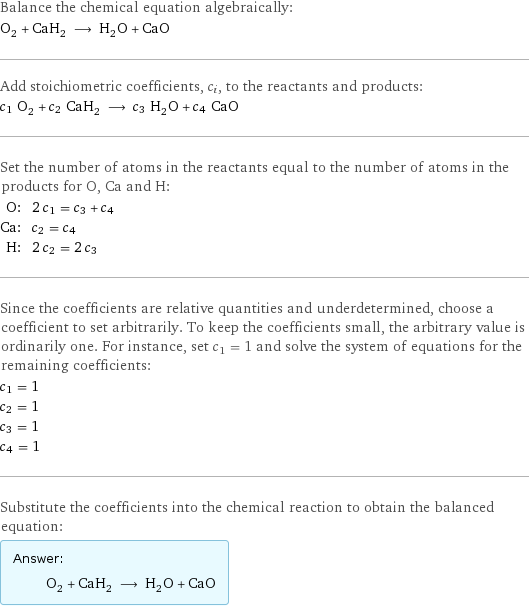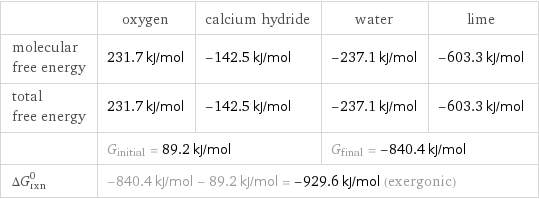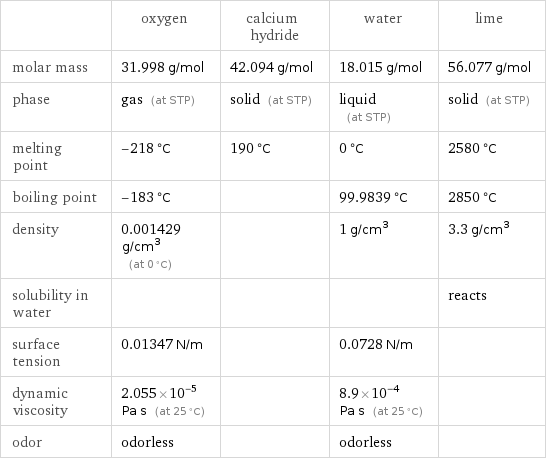Input interpretation

O_2 oxygen + CaH_2 calcium hydride ⟶ H_2O water + CaO lime
Balanced equation

Balance the chemical equation algebraically: O_2 + CaH_2 ⟶ H_2O + CaO Add stoichiometric coefficients, c_i, to the reactants and products: c_1 O_2 + c_2 CaH_2 ⟶ c_3 H_2O + c_4 CaO Set the number of atoms in the reactants equal to the number of atoms in the products for O, Ca and H: O: | 2 c_1 = c_3 + c_4 Ca: | c_2 = c_4 H: | 2 c_2 = 2 c_3 Since the coefficients are relative quantities and underdetermined, choose a coefficient to set arbitrarily. To keep the coefficients small, the arbitrary value is ordinarily one. For instance, set c_1 = 1 and solve the system of equations for the remaining coefficients: c_1 = 1 c_2 = 1 c_3 = 1 c_4 = 1 Substitute the coefficients into the chemical reaction to obtain the balanced equation: Answer: | | O_2 + CaH_2 ⟶ H_2O + CaO
Structures

+ ⟶ +
Names

oxygen + calcium hydride ⟶ water + lime
Reaction thermodynamics
Enthalpy

| oxygen | calcium hydride | water | lime molecular enthalpy | 0 kJ/mol | -181.5 kJ/mol | -285.8 kJ/mol | -634.9 kJ/mol total enthalpy | 0 kJ/mol | -181.5 kJ/mol | -285.8 kJ/mol | -634.9 kJ/mol | H_initial = -181.5 kJ/mol | | H_final = -920.7 kJ/mol | ΔH_rxn^0 | -920.7 kJ/mol - -181.5 kJ/mol = -739.2 kJ/mol (exothermic) | | |
Gibbs free energy

| oxygen | calcium hydride | water | lime molecular free energy | 231.7 kJ/mol | -142.5 kJ/mol | -237.1 kJ/mol | -603.3 kJ/mol total free energy | 231.7 kJ/mol | -142.5 kJ/mol | -237.1 kJ/mol | -603.3 kJ/mol | G_initial = 89.2 kJ/mol | | G_final = -840.4 kJ/mol | ΔG_rxn^0 | -840.4 kJ/mol - 89.2 kJ/mol = -929.6 kJ/mol (exergonic) | | |
Equilibrium constant
![Construct the equilibrium constant, K, expression for: O_2 + CaH_2 ⟶ H_2O + CaO Plan: • Balance the chemical equation. • Determine the stoichiometric numbers. • Assemble the activity expression for each chemical species. • Use the activity expressions to build the equilibrium constant expression. Write the balanced chemical equation: O_2 + CaH_2 ⟶ H_2O + CaO Assign stoichiometric numbers, ν_i, using the stoichiometric coefficients, c_i, from the balanced chemical equation in the following manner: ν_i = -c_i for reactants and ν_i = c_i for products: chemical species | c_i | ν_i O_2 | 1 | -1 CaH_2 | 1 | -1 H_2O | 1 | 1 CaO | 1 | 1 Assemble the activity expressions accounting for the state of matter and ν_i: chemical species | c_i | ν_i | activity expression O_2 | 1 | -1 | ([O2])^(-1) CaH_2 | 1 | -1 | ([CaH2])^(-1) H_2O | 1 | 1 | [H2O] CaO | 1 | 1 | [CaO] The equilibrium constant symbol in the concentration basis is: K_c Mulitply the activity expressions to arrive at the K_c expression: Answer: | | K_c = ([O2])^(-1) ([CaH2])^(-1) [H2O] [CaO] = ([H2O] [CaO])/([O2] [CaH2])](../image_source/5055e2c35c7e189a773004f2dbda217c.png)
Construct the equilibrium constant, K, expression for: O_2 + CaH_2 ⟶ H_2O + CaO Plan: • Balance the chemical equation. • Determine the stoichiometric numbers. • Assemble the activity expression for each chemical species. • Use the activity expressions to build the equilibrium constant expression. Write the balanced chemical equation: O_2 + CaH_2 ⟶ H_2O + CaO Assign stoichiometric numbers, ν_i, using the stoichiometric coefficients, c_i, from the balanced chemical equation in the following manner: ν_i = -c_i for reactants and ν_i = c_i for products: chemical species | c_i | ν_i O_2 | 1 | -1 CaH_2 | 1 | -1 H_2O | 1 | 1 CaO | 1 | 1 Assemble the activity expressions accounting for the state of matter and ν_i: chemical species | c_i | ν_i | activity expression O_2 | 1 | -1 | ([O2])^(-1) CaH_2 | 1 | -1 | ([CaH2])^(-1) H_2O | 1 | 1 | [H2O] CaO | 1 | 1 | [CaO] The equilibrium constant symbol in the concentration basis is: K_c Mulitply the activity expressions to arrive at the K_c expression: Answer: | | K_c = ([O2])^(-1) ([CaH2])^(-1) [H2O] [CaO] = ([H2O] [CaO])/([O2] [CaH2])
Rate of reaction
![Construct the rate of reaction expression for: O_2 + CaH_2 ⟶ H_2O + CaO Plan: • Balance the chemical equation. • Determine the stoichiometric numbers. • Assemble the rate term for each chemical species. • Write the rate of reaction expression. Write the balanced chemical equation: O_2 + CaH_2 ⟶ H_2O + CaO Assign stoichiometric numbers, ν_i, using the stoichiometric coefficients, c_i, from the balanced chemical equation in the following manner: ν_i = -c_i for reactants and ν_i = c_i for products: chemical species | c_i | ν_i O_2 | 1 | -1 CaH_2 | 1 | -1 H_2O | 1 | 1 CaO | 1 | 1 The rate term for each chemical species, B_i, is 1/ν_i(Δ[B_i])/(Δt) where [B_i] is the amount concentration and t is time: chemical species | c_i | ν_i | rate term O_2 | 1 | -1 | -(Δ[O2])/(Δt) CaH_2 | 1 | -1 | -(Δ[CaH2])/(Δt) H_2O | 1 | 1 | (Δ[H2O])/(Δt) CaO | 1 | 1 | (Δ[CaO])/(Δt) (for infinitesimal rate of change, replace Δ with d) Set the rate terms equal to each other to arrive at the rate expression: Answer: | | rate = -(Δ[O2])/(Δt) = -(Δ[CaH2])/(Δt) = (Δ[H2O])/(Δt) = (Δ[CaO])/(Δt) (assuming constant volume and no accumulation of intermediates or side products)](../image_source/f27cc4fbe97528a621989a8ab887d4e8.png)
Construct the rate of reaction expression for: O_2 + CaH_2 ⟶ H_2O + CaO Plan: • Balance the chemical equation. • Determine the stoichiometric numbers. • Assemble the rate term for each chemical species. • Write the rate of reaction expression. Write the balanced chemical equation: O_2 + CaH_2 ⟶ H_2O + CaO Assign stoichiometric numbers, ν_i, using the stoichiometric coefficients, c_i, from the balanced chemical equation in the following manner: ν_i = -c_i for reactants and ν_i = c_i for products: chemical species | c_i | ν_i O_2 | 1 | -1 CaH_2 | 1 | -1 H_2O | 1 | 1 CaO | 1 | 1 The rate term for each chemical species, B_i, is 1/ν_i(Δ[B_i])/(Δt) where [B_i] is the amount concentration and t is time: chemical species | c_i | ν_i | rate term O_2 | 1 | -1 | -(Δ[O2])/(Δt) CaH_2 | 1 | -1 | -(Δ[CaH2])/(Δt) H_2O | 1 | 1 | (Δ[H2O])/(Δt) CaO | 1 | 1 | (Δ[CaO])/(Δt) (for infinitesimal rate of change, replace Δ with d) Set the rate terms equal to each other to arrive at the rate expression: Answer: | | rate = -(Δ[O2])/(Δt) = -(Δ[CaH2])/(Δt) = (Δ[H2O])/(Δt) = (Δ[CaO])/(Δt) (assuming constant volume and no accumulation of intermediates or side products)
Chemical names and formulas

| oxygen | calcium hydride | water | lime formula | O_2 | CaH_2 | H_2O | CaO name | oxygen | calcium hydride | water | lime IUPAC name | molecular oxygen | calcium hydride | water |
Substance properties

| oxygen | calcium hydride | water | lime molar mass | 31.998 g/mol | 42.094 g/mol | 18.015 g/mol | 56.077 g/mol phase | gas (at STP) | solid (at STP) | liquid (at STP) | solid (at STP) melting point | -218 °C | 190 °C | 0 °C | 2580 °C boiling point | -183 °C | | 99.9839 °C | 2850 °C density | 0.001429 g/cm^3 (at 0 °C) | | 1 g/cm^3 | 3.3 g/cm^3 solubility in water | | | | reacts surface tension | 0.01347 N/m | | 0.0728 N/m | dynamic viscosity | 2.055×10^-5 Pa s (at 25 °C) | | 8.9×10^-4 Pa s (at 25 °C) | odor | odorless | | odorless |
Units
